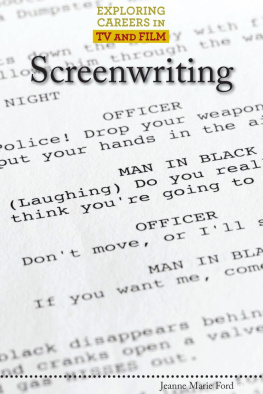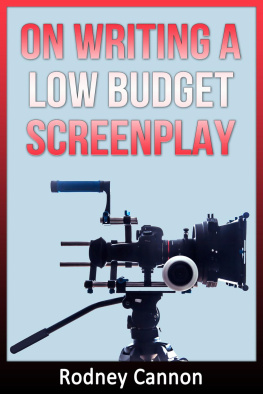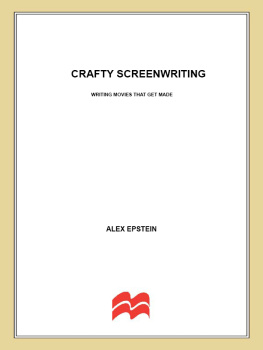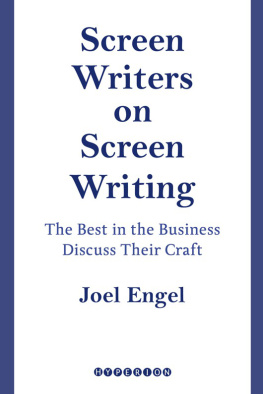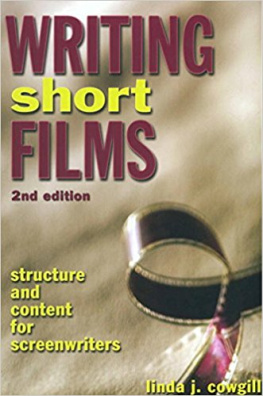FAST, CHEAP & WRITTEN THAT WAY Top Screenwriters on Writing for Low-Budget Movies ByJohn Gaspard Alberts Bridge Books Published by Alberts Bridge Books Minneapolis, MNManufactured in the United Sates of AmericaCopyright 2007, 2009 John Gaspard
All rights reserved. No part of this book may be reproduced in any form or by any means without permission in writing from the author, except for the inclusion of brief quotations in a review.
Library of Congress Cataloging-inPublication Data
Gaspard, John, 1958
Fast, Cheap and Written That Way / John Gaspard
ISBN: 1449585868 EAN-13: 9781449585860For Frantisek (Frank) Daniel, John Fenn, Sara Sexton and Jim White.
In this life, youre lucky to encounter one great teacher. I had the incredible good fortune of encountering four.Table of ContentsAcknowledgements Introduction
CHAPTER ONE: This Is Your Life 5 Living in Oblivion / Tom DiCillo
Metropolitan / Whit Stillman
Grief / Richard Glatzer
Venice/Venice / Henry Jaglom
CHAPTER TWO: Keeping It Real 57 Capote / Dan Futterman
Henry: Portrait of a Serial Killer / John
McNaughtonBubble / Coleman Hough
CHAPTER THREE: Based on a Short Story By ... 91 Personal Velocity / Rebecca Miller
Re-Animator / Stuart Gordon
Hester Street / Joan Micklin Silver
Sweet Land / Ali Selim
CHAPTER FOUR: The Play's The Thing 145 Tape / Stephen Belber
subUrbia / Eric Bogosian
CHAPTER FIVE: Playing With Genres 171 Martin / George Romero
Children Shouldn't Play With Dead Things /
Bob Clark
Suckers / Roger Nygard
Repo Man / Alex Cox
CHAPTER SIX: Love Stories 211 Love Letters / Amy Holden Jones
You Can Count On Me / Kenneth Lonergan Roger Dodger / Dylan Kidd
CHAPTER SEVEN: Original Visions 259 Paris, Texas / LM Kit Carson
Eve's Bayou / Kasi Lemmons
Me and You and Everyone We Know / Miranda
JulyFINAL CHAPTER: 30 Lessons 291
Afterword
The Movies
About the Author
AcknowledgementsA book of interviews with screenwriters would not be possible without the aid and assistance of the people who support those screenwriters -- their agents, managers, publicists and friends. Without their help, contact could not have been established and you'd be holding a book of blank pages in your hands right now. Iam grateful to all of them for their help. The ones who went above and beyond include: Richard Arlook,Monica De Armond, Toby Ascher, Lyne DuFort-Leavy,Scott Greenberg, Nicole Jefferson, Jennifer Levine, Tom Lieberman, Chris Romero, Bethany Schwartz, Ali Selim and Helen Springut.
The advice and counsel of friends was invaluable in selecting the films for this book and for ongoing and unending support: Matthew G. Anderson, Dale Newton,David Garfield, John Jansen and the original grown men: Patrick Coyle, Peter Moore, and Michael Paul Levin.
Daniel Berks deserves particular thanks for his careful editing and poofreading of the manuscript.
And finally thanks to my lovely wife, Amy, who patiently endured my absences during the long hours that it takes to cobble together a book like this.
IntroductionScreenwriting is easy.
At least, thats the impression youd come away with after reading many books and articles on low-budget filmmaking. In most youll find numerous instances of filmmakers talking about the arduous process of making the movie but precious little on how the script was actually written.
I realized this sad fact when I was proofing the companion book to this one, Fast, Cheap and Under Control: Lessons Learned From the Greatest Low-Budget Movies of All Time. Among all the wonderful gems gathered in that book I realized that there was really very little on the actual screenwriting process. The closest we got to any meat were phrases like, "The script justpoured out of me" or "So I sat down with my writing partner and we drafted a script." There was very little real information about the actual experience of writing.
Now, I don't want to come off as some sort of writing bigot, but the problem with screenplays is that they all look alike. Spread the pages of an Academy Award-winning script on a table nextto a properly formatted first draft by an ambitious neophyte and youd be hard pressed to tell the difference. At least, at a glance. And therein lies the problem.
To many people, if it looks like a screenplay and its formattedlike a screenplay well, it must be ready to be shot. Such is thedownfall of many an independent (and Hollywood) film.
The screenplay is arguably the most important element in thefilmmaking process and yet it remains the most mysterious. Someone goes off into a small, dark room and then a few days(weeks, months) later they emerge with a finished, polished script, ready to be shot.
Which begs this question: What the heck happened in that room? That, in a nutshell, is the goal of this book: To blow the doors off that room, peer over the writers' shoulders and crawl into theirbrains as they conceive, develop and refine the blueprint for theirmovies.
To that end, I spoke with twenty-three different screenwriters and got (not so surprisingly) twenty-three very different responses on how to go about writing a successful, low-budgetscreenplay.
A quick glance at the Table of Contents will demonstrate that I was able, with a lot of blood, sweat and e-mailing, to assembleinterviews that cover the last forty years of filmmaking and touch on just about every style and genre of low-budget filmmaking. I hand-picked movies that I think made a difference at the time they came out and that still have a lot to teach us.
Each writer very kindly detailed the steps they went through in the process of writing their low-budget script. In each instance,we talked about where they were in their career before that script how they conceived and developed the idea how they didor didn't adapt their work to their intended budget ... and theimpact that process has had on their subsequent work.
Interspersed with that chronology came their philosophy of screenwriting, and thats where it really gets interesting. These folks have opinions about what works, what doesnt, and whatswrong with movies today. You wont necessarily find agreement, or even consensus, on many points. But you willundoubtedly find a point of view that matches your own, alongwith some contrary ideas that are worth considering.
I've organized the interviews into like-minded genres, for easierreference, although to be fair, many of them span multiple topic headings. Henry Jaglom's Venice/Venice could easily move out of its current location (Chapter One: This is Your Life) and slide cleanly into Chapter Two: Keeping It Real or Chapter Six: Love Stories. The same is true of Roger Nygard's Suckers, whichwould be just as at home in Chapter One as in its current location, Chapter Five: Playing With Genres. And any of thescreenplays deserve a place in Chapter Six: Original Visions. But since everything has to be somewhere, for better or worsethis is where I've positioned these interviews.
Then, in the final chapter, I recap some of the key ideas that I took away from the interviews, providing my own (highly subjective) two cents on what I heard.
While I hope that you find much that inspires and motivates youin these conversations, never think for a moment that this project wasnt born out of anything more than my own selfish desire tochat with these writers and somehow, via osmosis or proximity, become a better screenwriter in the process.
The simple truth is, these folks are great storytellers. It wasterrific fun to sit back and listen to accounts of their low-budget high jinx.
[In the interest of full disclosure, I must confess that a few of theinterviews (Eric Bogosian, Alex Cox and portions of the Whit Stillman and Ali Selim interviews) were conducted by e-mail. However, their story-telling prowess came through the digital ether loud and clear. And while I'm disclosing things, the interview with Richard Glatzer about
Next page 

